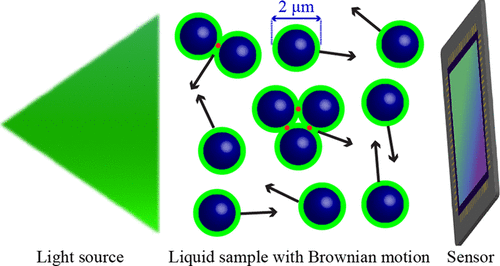Our official English website, www.x-mol.net, welcomes your feedback! (Note: you will need to create a separate account there.)
High-Speed Lens-Free Holographic Sensing of Protein Molecules Using Quantitative Agglutination Assays
ACS Sensors ( IF 8.9 ) Pub Date : 2021-02-15 , DOI: 10.1021/acssensors.0c02481 Zhen Xiong 1 , Colin J Potter 1 , Euan McLeod 1
ACS Sensors ( IF 8.9 ) Pub Date : 2021-02-15 , DOI: 10.1021/acssensors.0c02481 Zhen Xiong 1 , Colin J Potter 1 , Euan McLeod 1
Affiliation

|
Accurate, cost-effective, easy-to-use, and point-of-care sensors for protein biomarker levels are important for disease diagnostics. A cost-effective and compact readout approach that has been used for several diagnostic applications is lens-free holographic microscopy, which provides an ultralarge field of view and submicron resolution when it is coupled with pixel super-resolution techniques. Despite its potential as a diagnostic technique, lens-free microscopy has not previously been applied to quantitative protein molecule sensing in solution, which can simplify sensing protocols and ultimately enable measurements of binding kinetics in physiological conditions. Here, we sense interferon-γ (an immune system biomarker) and NeutrAvidin molecules in solution by combining lens-free microscopy with a one-step bead-based agglutination assay, enabled by a custom high-speed light-emitting diode (LED) array and automated image processing routines. We call this a quantitative large-area binding (QLAB) sensor. The high-speed light source provides, for the first time, pixel super-resolved imaging of >104 2 μm beads in solution undergoing Brownian motion, without significant motion blur. The automated image processing routines enable the counting of individual beads and clusters, providing a quantitative sensor readout that depends on both bead and analyte concentrations. Fits to the chemical binding theory are provided. For NeutrAvidin, we find a limit of detection (LOD) of <27 ng/mL (450 pM) and a dynamic range of 2–4 orders of magnitude. For mouse interferon-γ, the LOD is <3 ng/mL (200 pM) and the dynamic range is at least 4 orders of magnitude. The QLAB sensor holds promise for point-of-care applications in low-resource communities and where protocol simplicity is important.
中文翻译:

使用定量凝集测定法对蛋白质分子进行高速无透镜全息传感
用于蛋白质生物标志物水平的准确、经济高效、易于使用和即时的传感器对于疾病诊断非常重要。一种已用于多种诊断应用的具有成本效益且紧凑的读出方法是无透镜全息显微镜,当它与像素超分辨率技术相结合时,它可提供超大视场和亚微米分辨率。尽管无透镜显微镜具有作为诊断技术的潜力,但以前并未将无透镜显微镜应用于溶液中的定量蛋白质分子传感,这可以简化传感协议并最终能够测量生理条件下的结合动力学。在这里,我们通过将无透镜显微镜与一步基于珠的凝集试验相结合,检测溶液中的干扰素-γ(一种免疫系统生物标志物)和 NeutrAvidin 分子,由定制的高速发光二极管 (LED) 阵列和自动图像处理程序启用。我们称之为定量大面积结合 (QLAB) 传感器。高速光源首次提供>10像素的超分辨成像4 个2 μm 珠子在溶液中进行布朗运动,没有明显的运动模糊。自动图像处理程序可以对单个珠子和簇进行计数,提供取决于珠子和分析物浓度的定量传感器读数。提供了对化学结合理论的拟合。对于 NeutrAvidin,我们发现检测限 (LOD) <27 ng/mL (450 pM) 和 2-4 个数量级的动态范围。对于小鼠干扰素-γ,LOD 为 <3 ng/mL (200 pM),动态范围至少为 4 个数量级。QLAB 传感器有望在资源匮乏的社区和协议简单性很重要的即时护理应用中得到应用。
更新日期:2021-03-26
中文翻译:

使用定量凝集测定法对蛋白质分子进行高速无透镜全息传感
用于蛋白质生物标志物水平的准确、经济高效、易于使用和即时的传感器对于疾病诊断非常重要。一种已用于多种诊断应用的具有成本效益且紧凑的读出方法是无透镜全息显微镜,当它与像素超分辨率技术相结合时,它可提供超大视场和亚微米分辨率。尽管无透镜显微镜具有作为诊断技术的潜力,但以前并未将无透镜显微镜应用于溶液中的定量蛋白质分子传感,这可以简化传感协议并最终能够测量生理条件下的结合动力学。在这里,我们通过将无透镜显微镜与一步基于珠的凝集试验相结合,检测溶液中的干扰素-γ(一种免疫系统生物标志物)和 NeutrAvidin 分子,由定制的高速发光二极管 (LED) 阵列和自动图像处理程序启用。我们称之为定量大面积结合 (QLAB) 传感器。高速光源首次提供>10像素的超分辨成像4 个2 μm 珠子在溶液中进行布朗运动,没有明显的运动模糊。自动图像处理程序可以对单个珠子和簇进行计数,提供取决于珠子和分析物浓度的定量传感器读数。提供了对化学结合理论的拟合。对于 NeutrAvidin,我们发现检测限 (LOD) <27 ng/mL (450 pM) 和 2-4 个数量级的动态范围。对于小鼠干扰素-γ,LOD 为 <3 ng/mL (200 pM),动态范围至少为 4 个数量级。QLAB 传感器有望在资源匮乏的社区和协议简单性很重要的即时护理应用中得到应用。

























 京公网安备 11010802027423号
京公网安备 11010802027423号